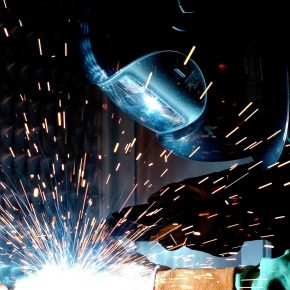
GUEST ARTICLE: 17 fires reported in the construction industry caused by hot works in Wales last year
CE Safety, the health and safety training provider, has submitted a Freedom of Information request to the Welsh Fire & Rescue Service, to find out the number of fires reported in the construction industry caused by hot works.
According to figures from Fire and Rescue Service in South Wales, there were 3 fires in buildings under construction caused by hot work. Two incidents were caused by soldering and one by welding. There were no injuries reported.
The North Wales Fire & Rescue Service confirmed that there was 1 fire incident in a building under construction. There were no casualties or fatalities recorded. The fire was caused by industrial equipment (welding/cutting equipment).
The Mid and West Wales Fire & Rescue Service recorded 13 incidents related to ‘welding equipment’ within various property types.
The causes were also divided into:
– Careless handling – due to careless disposal
– Combustible articles too close to a heat source (or fire)
– Natural occurrence
– Negligent use of equipment or appliance (heat source)
The Mid and West Fire & Rescue Service confirmed that there were no injuries reported.
Hot works refer to any task that requires using open flames or applying heat or friction which may generate sparks or heat.
More specifically, it is defined by the British Standards Institution (BSI) in BS 9999 as ‘any procedure that might involve or have the potential to generate sufficient heat, sparks or flame to cause a fire.’
Examples of hot works include welding, flame-cutting, soldering, brazing, grinding and the use of other equipment incorporating a flame.
Hot works pose a particular threat within the construction sector as the cause of multiple fires in buildings.
The most common examples of hot works and those that can pose significant risks without proper safety precautions are, for example:
– Brazing and soldering
– Gas/electric welding cutting apparatus
– Grinding wheels and cutting discs
– Thawing pipes
– Open flames, blow lamps and blow torches
– Bitumen and tar boilers
– Hot air blowers and lead heaters
Gary Ellis, from CE Safety, commented: “A variety of industries, construction, in particular, may require hot work to be carried out in their premises as part of routine work activities. It is also frequently carried out as part of contractual work, which is common in construction.
“However, no matter who does it, they must know what kind of hazards hot work presents and how to prevent it from causing harm.”
The fire hazards posed by hot works
Flying sparks are the principal risk posed by hot works and they can easily get trapped in cracks, pipes, gaps, holes and other small openings, where they could potentially smolder and cause a fire to break out.
The debris and residue which hot work creates, such as flammable swarf, molten metals, slag, cinder, and filings, are often combustible.
Hot works can cause pipes to substantially heat up and easily transfer, through the process of conduction, to another flammable surface and cause a fire.
Failure to remove flammable materials or substances from a surface before commencing work means that they could easily become hot and cause a fire.
In certain environments, there may be potentially explosive vapours or gases in the air which are highly combustible and could ignite if exposed to hot works. In a similar vein, hot works could generate fumes which, in turn, create an explosive atmosphere.
Ellis added: “The consequences of these hazards can be severe and costly for any business. Injuries can result in workers taking time off work, while a serious fire could damage a building irreparably.
“Both of these could even lead to legal consequences under certain circumstances. Therefore, it is crucial to understand how to implement appropriate safety controls.”
Due to the high-risk nature of hot works, the BS 9999 and the Health & Safety Executive (HSE) outline various safety procedures which organisations must adhere to. Their aim is to protect workers from dangerous aspects of hot work and to prevent fires from breaking out.
Latest news

26th July 2024
Enfield Speciality Doors completes world-class project for Atlas Copco HQ
A rundown office and warehouse building completely transformed into a modern headquarters for Atlas Copco has been fitted with more than 120 internal fire doors from Enfield Speciality Doors.
Posted in Access Control & Door Entry Systems, Articles, Building Industry News, Building Products & Structures, Building Systems, Case Studies, Doors, Interior Design & Construction, Interiors, Posts, Restoration & Refurbishment, Retrofit & Renovation, Security and Fire Protection, Sustainability & Energy Efficiency, Timber Buildings and Timber Products, Wooden products
26th July 2024
Abloy UK launches new white paper
Abloy UK, a leading provider of security and access control solutions, has launched a new white paper.
Posted in Access Control & Door Entry Systems, Architectural Ironmongery, Articles, Building Industry News, Building Products & Structures, Building Services, Doors, Facility Management & Building Services, Health & Safety, Information Technology, Innovations & New Products, Publications, Research & Materials Testing, Security and Fire Protection
26th July 2024
MCRMA Member Profile: David Roy, Director of Roofconsult
David Roy of MCRMA member company Roofconsult has more than 50 years’ experience to draw upon working in the building envelope sector and a unique perspective on how it has changed in that time.
Posted in Articles, BIM, Infrastructure & CAD Software, Building Associations & Institutes, Building Industry News, Building Products & Structures, Building Services, Building Systems, Cladding, Information Technology, Restoration & Refurbishment, Retrofit & Renovation, Roofs, Walls
26th July 2024
Strand: Enhancing Door Functionality and Safety
Craig Fox, Sales Director for Strand Hardware, outlines how door industry professionals might apply door limiting stays…
Posted in Architectural Ironmongery, Articles, Building Industry News, Building Products & Structures, Building Services, Doors, Facility Management & Building Services, Health & Safety, Restoration & Refurbishment, Retrofit & Renovation
 Sign up:
Sign up: